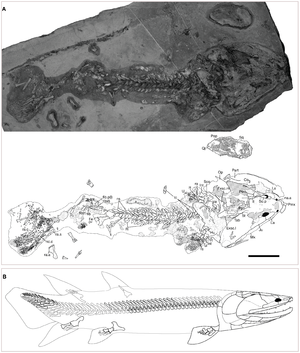Tinirau
| Tinirau | ||||||||||||
|---|---|---|---|---|---|---|---|---|---|---|---|---|

Holotype of clackae Tinirau and Reconstruction drawing |
||||||||||||
| Temporal occurrence | ||||||||||||
| upper Givetium ( Middle Devonian ) | ||||||||||||
| ~ 387 to 386 million years | ||||||||||||
| Locations | ||||||||||||
|
||||||||||||
| Systematics | ||||||||||||
|
||||||||||||
| Scientific name | ||||||||||||
| Tinirau | ||||||||||||
| Swartz , 2012 |
Tinirau is an extinct genus of fish from the class of meat fin fish(Sarcopterygii). Fossils of the species were in Simpson Park Mountains in Nevada found (USA) and by an index fossil of folding Erina disparilis - conodonts -Biozone the upper Givetian ( Middle Devonian assigned). Since the surrounding rock and nettle animal fossils from the order of Conulariden contains, starts from a marine habitat. The only species described so far is Tinirau clackae .
etymology
The genus was named after Tinirau , a figure in Polynesian mythology who is half fish and half human and master of marine life. The species epithet clackae honors the paleontologist Jenny Clack for her contribution to the understanding of the early legged sarcopterygians.
features
The description was based on an approximately 85 cm long holotype consisting of skull and postcranium and five paratypes, in which the skull has been completely or partially preserved and in two of which the postcranium and the limbs have been handed down.
Tinirau stands morphologically between Tristichopteridae and Elpistostegalia , shows in the anatomy of the fibula some similarities with later members of the trunk group of the Tetrapoda , but in contrast to the more advanced genera Panderichthys and Tiktaalik, it still has unpaired fins (dorsal and anal fin) and probably lived more aquatic than these. The skull, with which only 25% of the length in front of the midline extends through the orbit , corresponds more to the primitive flesh- fin fish such as the Rhizodontidae or the Canowindridae .
Systematics
Tinirau is assigned to the Eotetrapodiformes , a group of meat-floaters that showed increasing adaptation to an amphibious life and from which the land vertebrates (Tetrapoda) emerged.
The systematic position shows the following cladogram:
| Tetrapodomorpha |
|
||||||||||||||||||||||||||||||||||||||||||||||||||||||||||||||||||
|
|
literature
- Brian Swartz: A Marine Stem-Tetrapod from the Devonian of Western North America. PLoS ONE 7, 2012, doi : 10.1371 / journal.pone.0033683